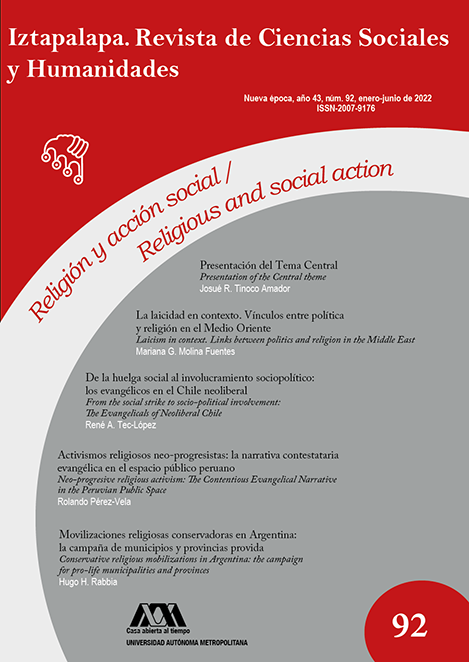La laicidad en contexto. Vínculos entre política y religión en el Medio Oriente
Palabras clave:
Estado laico, secularización, islamismo, Oriente PróximoResumen
Medio Oriente suele pensarse como una zona geográfica conflictiva en virtud de la existencia de grupos radicales que apuestan por el establecimiento de Estados islámicos. Sin embargo, ni el islam ni los proyectos políticos que lo recuperan como base son monolíticos u homogéneos. Para entenderlos es necesario situar históricamente el desarrollo de las relaciones entre lo político y lo religioso en los países que conforman la región. En este artículo se propone un análisis regional que recupera el vínculo entre secularización y laicidad a partir de la Primera Guerra Mundial. Para ello se refieren los casos concretos de Turquía, Arabia Saudí e Irán, que dan cuenta de la complejidad de ambos procesos y de la multiplicidad de las respuestas estatales frente a ellos.
Descargas
Citas
Al-Dakhil, Khalid 2009 “Wahhabism as an Ideology of State Formation”, en Mohammed Ayoob y Hassan Kosebalaban (eds.), Religion and Politics in Saudi Arabia, EUA, Lyne Rienner Publishing, pp. 23-38.
Alman, Mohammed 1982 Arabia Unified: A Portrait of ibn Saud, Gran Bretaña, Hutchinson Benham Limited.
Amnistía Internacional 2020 Países, disponible en: https://www.amnesty.org/es/countries/ Ardic, Nurullah 2012 Islam and the Politics of Secularism: The Caliphate and Middle Eastern Modernization in the Early 20th Century, Gran Bretaña, Routledge.
Anischenkova, Valerie 2020 “Emirate of Diriyah: The First Saudi State (1744-1818)”, en Modern Saudi Arabia, EUA, Greenwood Press, pp. 40-41.
Ansari, Ali 2019 Iran, Islam and Democracy: The Politics of Managing Change, Gran Bretaña, MacGuru.
Awan, Imran 2017 “Cyber-Extremism: Isis and the Power of Social Media”, Society, 54, pp. 138-149, doi: 10.1007/s12115-017-0114-0
Baraz, Yevgeniya 2010 “The Position of Jews and Christians in the Ottoman Empire”, Inquiries. Journal of Social Sciences, Arts and Humanities, 2(5), p. 1. Barkey, Karen
Baraz, Yevgeniya 2005 “Islam and Toleration: Studying the Ottoman Imperial Model”, Interna- tional Journal of Politics, Culture and Society, 19, pp. 5-19, doi: 10.1007/s 10767-007-9013-5
Beaubérot, Jean y Milot, Micheline 2011 Laïcités sans frontiers, Francia, Éditions du Sesuil.
Berger, Peter 1969 El dosel sagrado: elementos para una sociología de la religión, Argentina, Amorrortu.
Blancarte, Roberto 2008 Para entender el Estado laico, México, Nostra Ediciones.
Blancarte, Roberto 2012 “Religión y sociología. Cuatro décadas alrededor del concepto de secularización”, Estudios sociológicos, 30(S1), pp. 59-81, doi: 10.24201/ ES.2012V30NEXTRA.185
Brocket, Gavin 1998 “Collective action and the Turkish revolution: towards a framework for the social history of the Atatürk era, 1923-38”, Middle Eastern Studies, 34(4), pp. 44-66. https://doi.org/10.12658/human.society.5.9.M0121
Bullard, Reader 1963 “Persia in the two World Wars”, Journal of the Royal Central Asian Society, 50(1), pp. 6-20. https://doi.org/10.1080/03068376308731801
Casanova, José 1994 Public Religions in the Modern World, EUA, The Chicago University Press.
Chehabi, Houchang 2001 “The Political Regime of the Islamic Republic of Iran in Comparative Perspective”, Government and Opposition, 36(1), pp. 48-70.
Cleveland, William y Bunton, Martin 2016 A History of the Modern Middle East, EUA, Westview Press.
Conte, Amedeo 1994 “Forma performativa”, Anuario de filosofía del derecho, 11, pp. 381-392.
Craig, Gordon 1965 “The World War I Alliance of the Central Powers in Retrospect: The Military Cohesion of the Alliance”, The Journal of Modern History, 37(3), pp. 336-344.
Dabashi, Hamid 2017 Theology of Discontent: The Ideological Foundation of the Islamic Revo- lution in Iran, EUA, Routledge.
Deringli, Selim 2009 “Legitimacy Structures in the Ottoman State: The Reign of Abdülha- mid II (1876 – 1909)”, International Journal of Middle East Studies, 23(3), pp. 345-359.
Dobbelaere, Karel 1994 Secularización: un concepto multidimensional, México, Universidad Ibe- roamericana.
Durkheim, Émile 2014 Las formas elementales de la vida religiosa, México, Alianza Editorial.
El País 2016 “Arabia Saudí quita poder a la policía religiosa y desata la euforia juvenil”, El País, disponible en: https://elpais.com/internacional/2016/04/13/ actualidad/1460540987_734917.html
Eisenstadt, Shmuel Noah 2000 “Multiple Modernities”, Daedalus, 129(1), pp. 1-29.
Emre, Ahmet 2010 “The Period of One – Party State in Turkey and the Social Effects of Assassination Attempt to Mustafa Kemal Atatürk in 1935”, International Journal of Turkology, 5(2), pp. 13-19.
Finkel, Caroline 2007 Osman’s Dream: The History of the Ottoman Empire, EUA, Perseus Books Group.
Gallego, Éricka 2020 “Sugiere Bonilla consulta para matrimonio igualitario”, La Voz de la Frontera, disponible en: https://www.lavozdelafrontera.com.mx/local/ sugiere-bonilla-consulta-para-matrimonio-igualitario-4786601.html
Georgeon, François 2005 “Atatürk y la laicidad”, Revista de Historia Internacional, 6(22), pp. 31-39.
Ghods, Reza 1991 “Iranian Nationalism and Reza Shah”, Middle Eastern Studies, 27(1), pp. 35-45. https://doi.org/10.1080/00263209108700845.
Hambly, G.R.G. 1963 “Aqa Mohammad Khan and the establishment of the Qajar dynasty”, Journal of The Royal Central Asian Society, 50(2), pp. 161-174, https:// doi.org/10.1080/03068376308731821
Hanioğlu, Şükrü 1995 The Young Turks in Opposition, EUA, Oxford University Press.
Hervieu –Léger, Daniele y Champion, Francoise 1986 Vers un nouveau christianisme. Introduction à la sociologie du christianisme occidental, Francia, Éditions du Cerf.
Inglehart, Ronald y Norris, Pippa 2004 Sacred and Secular: Religion and Politics Worldwide, EUA, Cambridge University Press.
Karpat, Kemal 2010 Turkey’s Politics: The Transition to a Multi-Party System, EUA, Princeton University Press.
Kavas, Serap 2015 “Wardrobe Modernity: Western Attire as a Tool of Modernization in Turkey”, Middle Eastern Studies, 51(4), pp. 515- 539. https://doi.org/ 10.1080/00263206.2014.979802
Lampridi-Kemou Athina 2011 “Los Hermanos Musulmanes: ¿Una fuerza centrífuga o centrípeta?”, Revista CIDOB d’Afers Internacionals, Núm. 93, pp. 111-127.
Luckmann, Thomas 1967 The Invisible Religion; The Transformation of Symbols in Industrial Society, Inglaterra, MacMillan.
Mahmood, Mohammad 2006 The Political System of the Islamic Republic of Iran, India, Kalpaz Publi- cations.
Malthaner, Stefan 2011 Mobilizing the Faithful: Militant Islamist Groups and its Constituencies, EUA, Campus Verlag GmbH.
Martin, David 1979 A General Theory of Secularization, EUA, Harper Colophon Books
Mashayekhi, Azadeh 2015 “Tehran, the Scene of Modernity in the Pahlavi Dynasty: Moderni- sation and Urbanisation Processes, 1925-1979”, en Fatemeh Arefian y Seyed Hossein Moeini (eds.) Urban Change in Iran: Stories of Rooted Histories and Ever- accelerating Developments, Gran Bretaña, Springer, pp. 103-111.
Milani, Mohsen 2018 The Making of Iran’s Islamic Revolution: From Monarchy to Islamic Repu- blic, EUA, Routledge.
Ochsenwald, William 1984 Religion, Society, and the State in Arabia: The Hijaz under Ottoman Control, 1840-1908, EUA, The Ohio University Press.
Olson, Robert 2000 “The Kurdish Rebellions of Sheikh Said (1925), Mt. Ararat (1930), and Dersim (1937-8): Their Impact on the Development of the Turkish Air Force and on Kurdish and Turkish Nationalism”, Die Welt des Islams, 40(1), pp. 67-94.
Rodríguez, León 1991 La revolución islámica-clerical de Irán: 1978-1989, México, El Colegio de México.
Sanjuan, Casimiro 2016 “Daesh. Evaluación de sus objetivos y posibles líneas de acción”, Boletín IEEE, 3, pp. 601-612.
Sarrazin, Jean – Paul 2018 “Religión: ¿sabemos de lo que estamos hablando? Examen sobre la viabilidad de una categoría analítica para las ciencias sociales”, Criterio libre, 16(29), pp. 67-84.
Sykes, Percy 2016 A History of Persia, Gran Bretaña, Hesperides Press.
Teitelbaum, Joshua 1998 “Sharid Husayn ibn Ali and the Hashemite vision of the post-Ottoman order: from chieftancy to suzerainity”, Middle Eastern Studies, 34(1), pp. 103-122.
Tschannen, Olivier 1991 “The Secularization Paradigm: A Systematization” en Journal for the Scientific Study of Religion (EUA), 30(4), pp. 395-415, doi: 10.2307/1387276
Ulrichsen, Kristian y Sheline, Annelle 2019 “Mohammed bin Salman and Religious Authority and Reform in Saudi Arabia”, Rice University’s Baker Institute for Public Policy, disponible en: https://scholarship.rice.edu/bitstream/handle/1911/108116/bi-report- 092319-cme-mbs-saudi.pdf?sequence=1
Urquidi, Víctor 2005 “Perspectiva de la población mundial”, Estudios Demográficos y Urbanos, 20(1), pp. 9-21.
Vera, Rodrigo 2018 “Arzobispo Primado respalda propuesta de Mikel Arriola contra aborto y bodas gay”, Proceso, disponible en: https://www.proceso.com. mx/522873/arzobispo-primado-respalda-propuesta-de-mikel-arrio- la-contra-aborto-legal-y-bodas-gay
Vogel, Frank 2000 Islamic Law and the Legal System of Saudi: Studies of Saudi Arabia, Países Bajos, Brill.
Voll, John 2009 “The Impact of Wahhabi Tradition”, en Ayoob, Mohammed y Kose- balaban, Hassan (Editores), Religion and Politics in Saudi Arabia, EUA, Lyne Rienner Publishing, pp. 149-168.
Weber, Max 1983 Ensayos sobre sociología de la religión, España, Taurus.
Yarshater, Ehsan 2001 “The Qajar Era in the Mirror of Time”, Iranian Studies, 34(1), pp. 187- 194.
Yasamee, Fak 2013 “Abdülhamid II and the Ottoman Defense Problem”, Diplomacy and Sta- tecraft, 4(1), pp. 20-36. http://dx.doi.org/10.1080/09592299308405871
Ye’or, Bat 1985 The Dhimmi: Jews and Christians under Islam, EUA, Associated Univer- sity Presses.




.jpg)

.png)
.jpg)




.png)
.png)
1.png)
